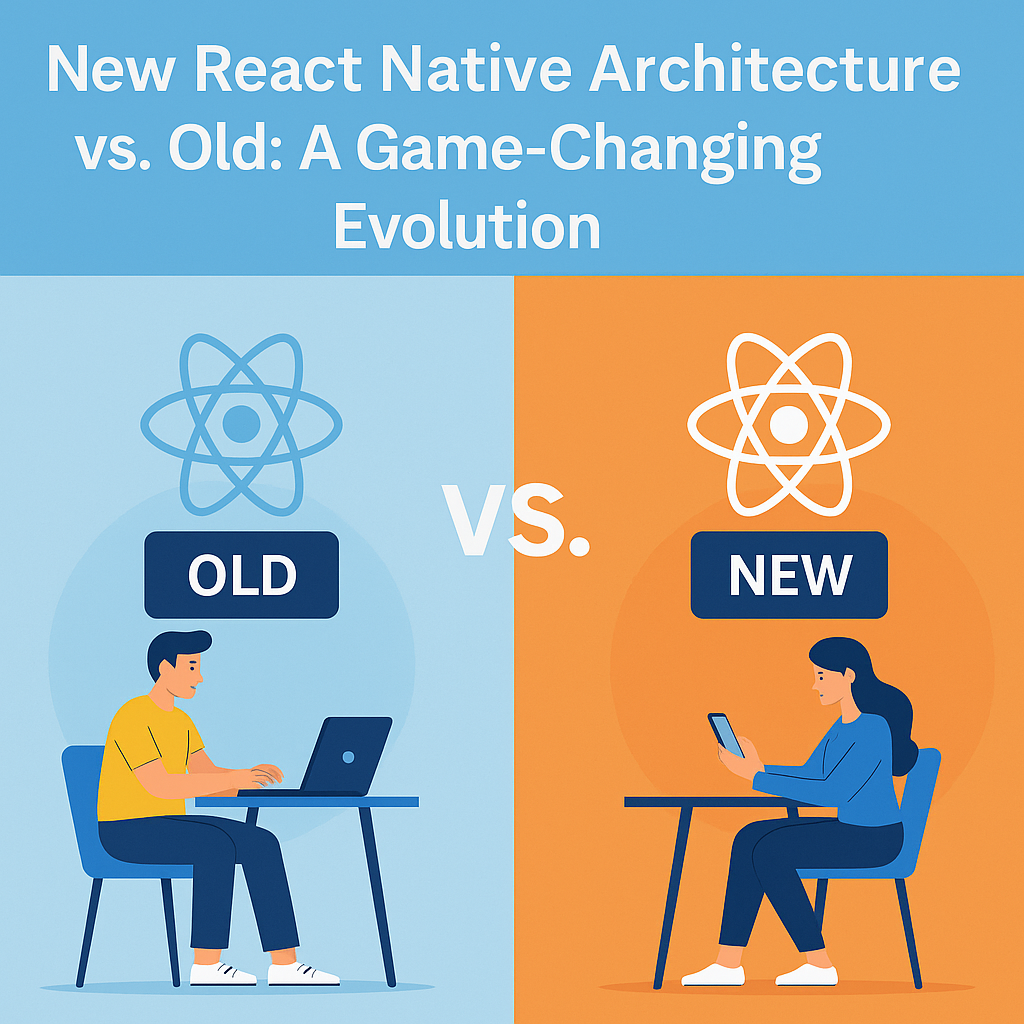Software developmentdifficulty
New React Native Architecture vs. Old: A Game-Changing Evolution
React Native has revolutionized cross-platform mobile app development, but its original bridge-based architecture struggled with modern demands. The New Architecture, introduced in React Native 0.76 (2024), overhauls this with faster performance and smoother UIs. This Medium-inspired article compares the old and new architectures, highlights updates, and shares a practical example. Let’s explore why this shift matters.
M
Muhammad Aamir Yameen
06-04-2025
27 mint mint read

React Native has revolutionized cross-platform mobile app development, but its original bridge-based architecture struggled with modern demands. The New Architecture, introduced in React Native 0.76 (2024), overhauls this with faster performance and smoother UIs. This Medium-inspired article compares the old and new architectures, highlights updates, and shares a practical example. Let’s explore why this shift matters.
The Old Architecture: Innovative but Limited
The old architecture used three threads:
- JavaScript Thread: Ran app logic via JavaScriptCore.
- Native/UI Thread: Rendered native components and handled inputs.
- Shadow Thread: Calculated layouts with Yoga.
A bridge serialized data into JSON for communication, causing issues:
- Latency: JSON serialization slowed UI updates, leading to lag.
- Slow Startup: Preloading all native modules bloated launch times.
- Debugging: Bridge separation made debugging native modules tough.
For example, updating a to-do app’s 500-task list via the bridge could take ~300ms, causing UI jank on budget devices like a Samsung A10.
The New Architecture: A Modern Leap
The New Architecture eliminates the bridge, using:
- JSI (JavaScript Interface): Enables direct, synchronous JavaScript-native communication, skipping JSON.
- Fabric: A C++-based rendering engine with concurrent rendering for smooth UIs.
- TurboModules: Loads native modules on-demand, cutting startup time.
- Codegen: Auto-generates type-safe interfaces, reducing errors.
Paired with the Hermes engine, it supports React 18 features like Suspense and automatic batching for dynamic UIs.
🔄 Key Differences at a Glance
| Feature | Old Architecture | New Architecture (2025) |
| Rendering Engine | Legacy UI Manager | Fabric Renderer |
| Communication | Bridge (JSON serialized, async) | JSI (Synchronous, direct C++/JS interface) |
| Module System | Native Modules (eager loading) | TurboModules (lazy-loaded, efficient) |
| Code Binding | Manual binding (verbose, error-prone) | CodeGen (automatic, type-safe bindings) |
| Startup Time | Slower due to full module loading | Faster with lazy-loading modules |
| Performance | Prone to lags with complex animations | Native-like fluidity and better FPS |
| Debugging Tools | Limited native insights | Enhanced tooling and better diagnostics |
| Memory Usage | Higher due to always-on modules | Lower thanks to on-demand initialization |
Key Benefits
- Faster Performance: JSI cuts latency; rendering 1,000 chat messages is ~20% faster.
- Smoother UIs: Fabric prioritizes gestures, ensuring seamless swipes in apps like e-commerce carousels.
- Quicker Startup: TurboModules reduce launch times by ~600ms on devices like the Xiaomi Redmi 9.
- Better Debugging: Improved DevTools and Codegen streamline development.
- Future-Ready: Supports React 18, enabling libraries like @shopify/flash-list.
Example: Fitness App Dashboard
In a fitness app with 800 workout logs, the old architecture’s JSON bridge took ~400ms to update the dashboard, causing scroll lag. The New Architecture’s JSI reduces this to ~120ms, with Fabric ensuring smooth scrolling and TurboModules cutting startup by ~500ms on an Oppo A5s. The result is a native-like experience.
Old vs. New
- Communication: Old: JSON bridge (slow); New: JSI (fast).
- Rendering: Old: Async, laggy; New: Concurrent, smooth.
- Modules: Old: Preloaded, slow; New: Lazy-loaded, efficient.
- Debugging: Old: Complex; New: Streamlined.
- React Support: Old: Limited; New: Full React 18 compatibility.
Migration Tips
Upgrade to React Native 0.76+ and check library compatibility with React Native Directory (https://reactnative.directory/) or npx expo-doctor@latest. Refactor custom modules for JSI/TurboModules. The interoperability layer supports old components temporarily, but full migration maximizes benefits. Use React Native Upgrade Helper (https://react-native-community.github.io/upgrade-helper/).
Why Migrate Now?
Over 70% of Expo SDK 52+ projects use the New Architecture (April 2025, per X). The old architecture is frozen, with deprecation looming by late 2025. Migrating ensures performance, security, and community support.
Conclusion
The New Architecture replaces the bridge with JSI, Fabric, and TurboModules, delivering faster, smoother apps. From responsive fitness dashboards to lag-free chat feeds, the benefits are clear. Migrate now to stay ahead and build apps that feel truly native.
References
- React Native Docs: https://reactnative.dev/docs/new-architecture-intro
- Stacksgather: https://stacksgather.com/
- Medium Articles: https://medium.com/tag/react-native
- GitHub Discussions: https://github.com/reactwg/react-native-new-architecture
- Expo Guide: https://docs.expo.dev/guides/new-architecture/
M
Muhammad Aamir Yameen
Software Engineer